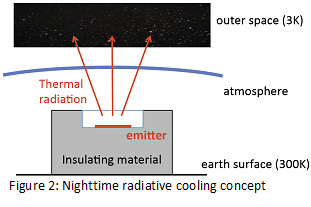Start Date: September 2014
PDF version
Investigator
Shanhui Fan, Department of Electrical Engineering, Stanford University
Objective
The goal of this research is to create a device that generates electricity at night by radiating heat into outer space. This passive energy source, which exploits the large temperature difference between space and Earth, could provide nighttime refrigeration without batteries or other electrical inputs. Experimental efforts will demonstrate equilibrium temperatures that are 50K below ambient. The ability to passively maintain ultra-low temperatures significantly below the ambient temperature would be a breakthrough in the field of thermal sciences. The experimental device will incorporate novel nanophotonic structures and optimized thermal design. Theoretical models will elucidate the fundamental limits of nighttime radiative cooling.
Background
The sun provides a near-ideal heat source at a temperature close to 6,000K. Significant efforts have been made to harvest light and heat from the sun. Less widely recognized is the potential of outer space as a source of energy. At a global scale, radiative cooling is the dominant mechanism through which the earth’s surface cools down at night. Outer space offers a near-ideal heat sink with a temperature of 3K. Since the Earth’s atmosphere has a transparency window in the 8-13 micron range, any emitter that generates strong thermal radiation in this range will lose heat to outer space. For example, an object on Earth with a temperature near 300K (270C) can radiate heat through the atmosphere to outer space in the form of thermal electromagnetic waves. Figure 1 shows the Earth’s transmission spectrum overlaid by the emission spectrum of a blackbody object. Figure 2 depicts the nighttime cooling concept. As a practical cooling mechanism, radiative cooling is completely passive and requires no electrical input. It therefore has the potential to reduce the electricity required for air-conditioning, refrigeration and nighttime lighting.

Figure 1: The black curve is the transmission spectrum of the Earth’s atmosphere. The red curve is the emission spectrum of a 300 K blackbody. The peak of the emission spectrum coincides with the transparency window between 8 to 13 microns of the atmosphere.
Approach
 Commercial systems for nighttime radiative devices have achieved a temperature reduction in the 15 K- to-20 K range. This modest performance is due to limitations of the thermal-radiator designs and poorly managed parasitic heat loads. To out-perform these conventional systems, a nighttime radiative device should incorporate two features: 1) strong emission selectivity in the emitter, and 2) suppression of parasitic heat loads in the overall apparatus.
Commercial systems for nighttime radiative devices have achieved a temperature reduction in the 15 K- to-20 K range. This modest performance is due to limitations of the thermal-radiator designs and poorly managed parasitic heat loads. To out-perform these conventional systems, a nighttime radiative device should incorporate two features: 1) strong emission selectivity in the emitter, and 2) suppression of parasitic heat loads in the overall apparatus.
Nanophotonic thermal emitter: The focus of the research will be to design and fabricate a thermal emitter with nanophotonic structures that enhance thermal radiation in the mid-infrared wavelength range of the atmospheric transparency window. Previous radiative-cooling concepts have relied on single materials and their intrinsic optical properties to achieve selectivity. The result has been compromised performance. However, no ideal material exists. Nanophotonic design provides an opportunity to overcome material limitations by engineering the presence or absence of photonic states to induce the required selectivity in thermal emission. Through photonic crystal and metamaterial design, the research team can achieve a degree of control over the emissivity and spectral selectivity of a structure.
 Minimize parasitic heat losses: The thermal design of the apparatuses that contain the radiative cooler will be reconfigured. The conventional design allows internal convection in the air pocket, which creates a parasitic heat load. The research team will design and build a portable vacuum chamber system to replace the sealed air region (Figure 3). The new system will also have a large mid-infrared-transparent window that will help achieve extremely low coefficients of non-radiative heat exchange.
Minimize parasitic heat losses: The thermal design of the apparatuses that contain the radiative cooler will be reconfigured. The conventional design allows internal convection in the air pocket, which creates a parasitic heat load. The research team will design and build a portable vacuum chamber system to replace the sealed air region (Figure 3). The new system will also have a large mid-infrared-transparent window that will help achieve extremely low coefficients of non-radiative heat exchange.


